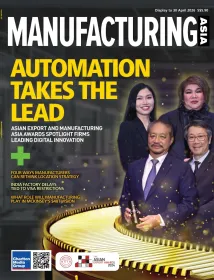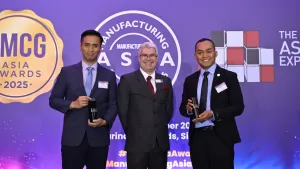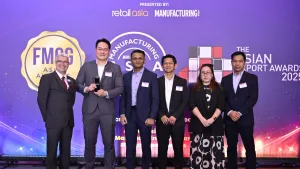
EY's Atul Chandna delves into key strategies for balancing manufacturing output excellence, integrating sustainability
Atul Chandna highlights the role of supply chain resilience, technological innovation, sustainability, and operational excellence in the manufacturing and export sectors.
The manufacturing and export sectors have long been the backbone of global trade, driving economic growth and fostering international collaboration. In a rapidly changing world marked by disruptions and evolving consumer demands, the ability to navigate these challenges whilst embracing sustainability and technological innovation is paramount.
Atul Chandna, EY Asia-Pacific Supply Chain Leader, offers invaluable insights into these critical aspects given his extensive experience in the field. Chandna's distinguished career has been characterised by his profound knowledge of sales and supply chain functions, particularly in the consumer goods, retail, and chemicals sectors across the Asia-Pacific region. His work involves supporting clients from conceptualisation to the final delivery of large-scale turnaround programmes. He has also led innovative engagements in digital supply chain transformation, as well as advanced supply chain analytics and process consulting projects. In a world where supply chains are constantly tested by unforeseen disruptions, Chandna emphasised the importance of resilience. He noted that in the face of crises, such as the COVID-19 pandemic, geopolitical tensions, and environmental pressures, supply chain resilience becomes a critical factor for manufacturers and exporters. Chandna also stressed that embracing digital innovation is pivotal. By leveraging technologies like AI and advanced analytics, supply chains can achieve real-time visibility into data, enabling them to match supply with demand seamlessly.
In your experience, how can manufacturers and exporters enhance their supply chain resilience to mitigate disruptions and ensure uninterrupted export operations?
In today’s disruptive world, supply chain resilience is crucial as it can make or break a business. The COVID-19 pandemic, increasing China-US tensions, the Russia-Ukraine war, environmental, social and governance (ESG) pressures, and many other disruptions have both direct and indirect implications for manufacturers and exporters. The world is becoming highly interconnected, and manufacturers and exporters will need exceptional competencies to gain a competitive advantage. This includes leveraging AI-powered technologies and advanced analytics, which will play an ever-increasing role in reducing opacity and other complications in today’s supply chains, and help in sustainable sourcing, being compliant and having a seamlessly integrated supply chain. By 2035, 45% of supply chains are expected to be mostly autonomous. With that, exporters and manufacturers can instantly respond to changes in customer demand and adjust supply plans and production schedules in real-time, making the supply chain more flexible, efficient, and optimised. Sustainable supply chains will also become an imperative. Shifting to a circular model will simplify sourcing and be more sustainable. Supplier and component selection as per the ESG and United Nations Sustainable Development Goals (UN SDG) guidelines are some of the other important aspects for consideration. Having shorter and localised supply chains through nearshoring or reshoring operations can reduce the risk of disruptions and improve resilience. This further ensures flexibility and faster responses to changing customer demand, improving operational margins whilst avoiding tariffs and reducing carbon footprint.
Technology plays a pivotal role in modernising export operations. From your perspective, what specific technological innovations have the potential to significantly boost export capabilities?
Technology has emerged as a driving force in reshaping and modernising export operations. From streamlined logistics to enhanced customer engagement, technological innovations have revolutionised the way manufacturers and exporters navigate the complexities of international trade. With the advent of blockchain, artificial intelligence, IoT devices, and other cutting-edge solutions, traditional export practices are being transformed into efficient, agile, and interconnected processes that cater to the demands of a digitally connected world. This paradigm shift not only accelerates the pace of cross-border commerce but also empowers exporters to proactively respond to challenges and seize new opportunities, ultimately ushering in a new era of seamless and resilient international trade. Some examples of technology innovations include:
Blockchain. This can be leveraged to integrate supply chain processes across ecosystem partners and improve collaborations between multiple stakeholders. Additionally, given the increasing pressures to meet ESG reporting requirements, there is a heightened need for end-to-end visibility and traceability in the areas of tracking carbon emissions, circular economy, and waste management.
Big data and analytics. Analysing large sets of data can offer insights into market trends, customer preferences and demand patterns. This data-driven approach aids decision-making and enables manufacturers to tailor their export strategies to meet evolving market needs.
IoT (Internet of Things). IoT devices can track and monitor shipments, providing real-time visibility into the location, condition, and status of goods in transit. This helps optimise logistics, prevent theft, and minimise delays, improving overall export efficiency.
Robotics and automation. Automation can streamline manufacturing processes, reduce human error and improve consistency in product quality. This can lead to more reliable exports and faster order fulfilment.
In your opinion, how can manufacturers achieve a balance between achieving excellence in manufacturing output and integrating sustainability measures?
As industries evolve and environmental concerns intensify, manufacturers are compelled to rethink their operational strategies. The convergence of efficient production practices with sustainable initiatives not only aligns with ethical and ecological imperatives but also brings forth a range of benefits, spanning from resource optimisation and cost savings to enhanced brand reputation. Striking this delicate balance requires a strategic approach that fuses innovation, technology, and conscientious resource management, thereby setting the stage for manufacturing excellence that is both forward-looking and environmentally responsible. Some examples include: Determine organisational-wide commitments and goals to prioritise their efforts and strike a balance between manufacturing output and integration of sustainability measures that are in line with the organisation’s wants. Develop an ROI-backed roadmap to meet sustainability performance goals to provide realistic targets. The roadmap should include cost reduction, revenue growth, risk management and intangibles. Focus on end-to-end supply chain transformation and take on a more holistic view to identify areas to integrate sustainability measures instead of only focusing on procurement or cost savings. Leverage technology to increase transparency and visibility of work processes and sustainability efforts to enhance accountability.
In today's globalised manufacturing landscape, cross-cultural collaboration is crucial. What strategies do you recommend for fostering effective collaboration and shared purpose amongst manufacturing teams from diverse backgrounds and regions?
With cross-cultural and virtual collaboration, it is important for manufacturers to invest in collaborative technologies such as cloud platforms and digital control towers that provide real-time insights into the work processes across business functions and borders. Strong leadership in facilitating communication and cultural exchange between different teams will be key. To foster effective collaboration and a shared purpose amongst manufacturing teams, enterprises should consolidate, simplify, and standardise the end-to-end operating model to minimise points of friction. Additionally, opportunities to have shared responsibility between cross-cultural teams would give them a shared purpose to work towards. Having the representatives of cross-cultural teams convene every week to review their performance and progress against specified key performance indicators with a strong manager reinforces accountability and ensures a smooth process.
Looking forward, what emerging trends do you anticipate will have the most profound impact on the export and manufacturing sectors, particularly in the Asia-Pacific region?
Asia-Pacific’s economies generally remain resilient, with investors expressing renewed confidence in long-term opportunities. Strategic investment, economic conditions, and talent will be high on the board’s agenda for long-term success. One of the trends to watch is the changing habits and demands of consumers. Understanding the preferences and habits of the next generation of consumers and workforce will be key to maintaining a competitive advantage now and beyond. The climate crisis is the defining issue of our time. Whilst specific sectors, particularly automotive, energy and manufacturing, are more advanced in embedding climate action into the heart of their business strategy, all boards should already be addressing climate risk as a standing item on their agendas.
In your capacity as a judge for the Manufacturing Asia Awards and Asian Export Awards, what specific aspects of standout initiative do you believe demonstrate its harmonious integration of technology, sustainability, and operational efficiency?
Previously, many companies were still battling with the COVID-19 restrictions in several markets. This year, we are seeing more people and goods mobility, so I’ll be looking forward to seeing the initiatives that businesses have undertaken to improve resilience and overall efficiency. For example, what differentiated or innovative practices did the company adopt to enhance their offering? Is the initiative scalable and adaptable to withstand the rapidly evolving landscape and achieve long-term success? Does the initiative fulfil any of the sustainable development goals or clearly showcase sustainability ambitions?

















